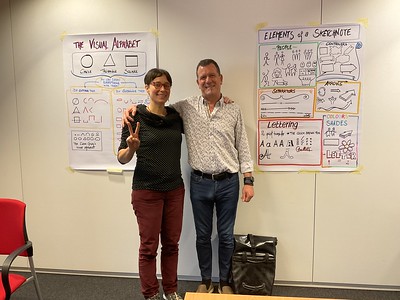As 2024 draws to a close, I’ve been reflecting on the feedback we’ve received from participanting colleagues of the “StartSketch: The Basics of Sketchnoting” course. Some 161 colleagues from across the European institutions took part in this immersive, one-day, face-to-face training in the basics of visual thinking. Since end of 2023, we(*) ran 10 sessions in total, held not just in Brussels but also in Ispra, Italy, and Luxembourg.
An impressive 65% of participants responded to the post-course evaluation—a high response rate that we greatly appreciate. And their feedback? A staggering overall rating of 9.5 out of 10. Incredible! We’re deeply grateful for such positive reviews. They inspire us to keep sharing the basics of visual thinking with passion and professionalism, proving that there is a great need for more visual thinking as a tool for reflection and work within EU institutions.
Curious about the impact of the course, I turned to a generative AI tool to summarise participants’ answers to the question, “What is the most valuable thing you have learned that you will apply in your work?” The results were fascinating, see below, and I couldn’t resist illustrating them with a sketchnote.
(*) This course has been a labour of love from the start, and I must thank Catherine Focant, who co-created it with me. As I’ve mentioned in a previous post, Catherine and I dreamed of introducing visual thinking and sketchnoting training within the European institutions for over a decade. Although we only had the chance to deliver the course together twice, her influence and input were invaluable. For personal reasons, Catherine couldn’t continue, which remains a source of sadness for me. Since then, Célia Pessaud has generously stepped in to co-facilitate the course with me. Her enthusiasm and dedication have been incredible, and I’m so grateful for her support.
To both Catherine and Célia, I want to express my heartfelt thanks for sharing this journey of spreading visual thinking skills within our European institutions. It’s been a joy to combine our passions and expertise to make this dream a reality.
What do participants say about our Sketchnoting course?
- Sketchnoting is a valuable skill: Many participants found sketchnoting to be a useful tool for their work, allowing them to take notes, communicate ideas, and summarise complex information in a visual and engaging way.
- It’s not about being a good artist: Participants learned that sketchnoting is not about creating perfect drawings, but about using simple shapes and visuals to convey ideas and information, breaking free from perfectionism.
- Breaking down complex ideas: Sketchnoting helps to break down complex ideas into simple, easy-to-understand visuals, making it easier to communicate and remember information, distilling complex ideas to their essence.
- Improved note-taking and communication: Participants found that sketchnoting improved their ability to take notes, communicate ideas, and engage with colleagues and audiences, making communication more effective, engaging, and memorable.
- Increased creativity and confidence: The course helped participants to think creatively and build confidence in their ability to sketch and communicate visually, encouraging creativity and having fun with the process.
- Practical applications: Participants identified various ways to apply sketchnoting in their work, including taking notes during meetings, creating presentations, and communicating with colleagues and stakeholders, seeing immediate applications in their work.
- Simple and fun: Many participants found sketchnoting to be a fun and enjoyable way to take notes and communicate, and appreciated the simplicity of the techniques and tools used, showing that sketchnoting can be a fun and relaxing process.
- Improved focus and engagement: Sketchnoting helped participants to stay focused and engaged during meetings and presentations, and to retain information more effectively, helping in organising ideas quickly and efficiently.
- Use of visuals and symbols: Participants learned about the importance of using visuals and symbols to summarize information, make notes more attractive, and communicate ideas more effectively, using basic shapes, icons, and symbols to represent ideas.
- Applicability to various contexts: Participants saw the potential for sketchnoting to be applied in various contexts, including work, education, and personal projects, expanding the skill and making it applicable beyond work.
- Visual thinking and empowerment: Learning to think visually and use sketchnoting to enhance understanding and memory was highly appreciated, empowering participants to continue sketchnoting and applying it in their work and personal life.
- Practical techniques and tools: Participants valued the practical techniques and tools provided, such as basic sketchnoting principles, drawing simple and recognisable sketches, and using icons and colours, providing practical tools such as symbols, basic shapes, and techniques for drawing icons, faces, and connectors.
- Creativity and inclusivity: Sketchnoting encourages a more engaging and informal approach to note-taking, making communication more inclusive, especially when working with colleagues or diverse audiences, and visualising ideas to make them accessible and engaging for everyone.
- Learning by doing: A number of respondents noted that sketchnoting requires practice and attention but becomes easier with time, and that the course helped participants gain confidence in their ability to learn and apply sketchnoting techniques.
- Training quality and resources: Several respondents praised the course’s quality, mentioning the professionalism, structure, and effectiveness of the trainers, and many respondents are looking for resources to further practice and improve their sketchnoting skills.
- Positive training experience: Overall, the course was seen as inspiring, empowering, and a fun experience that boosted confidence in using sketchnoting regularly, providing a positive learning experience with praise for the instructors’ expertise, the course structure, and the supportive learning environment.































